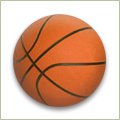Here, I’d like to talk a little about some important, but often overlooked, parts of a good rehabilitation program designed to not only return an injured basketball player to competition but to decrease his or her risk of further injury.
Since research has shown that basketball players with a history of ankle injury are almost 5 times more likely to sustain an ankle injury than those who have never been injured, it's important to take the extra steps to make sure you appropriately rehabilitate and protect your ankles before you get back in the game.
In the old days, basketball players were told to take some Non-Steroidal AntiInflammatory Drugs (NSAIDs) and Rest, Ice, Compress, and Elevate (RICE) their injured ankles for the first 24-48 hours after injury. That's still good advice because this first aid for ankle sprains will reduce the swelling (and pain, and amount of time you miss). After that, they were told to slowly "get back into it" and return to play when they could manage it.
Here's the problem with just returning when you feel ready -- the damage from an ankle sprain not only causes swelling, pain, stiffness and bruising,
- When ligaments and muscles are overstretched, they become less strong, and less able to support the body.
- When there's pain and swelling around the ankle, the muscles that move and support the ankle are used less often and can weaken, again becoming less able to support the joint and more likely to be re-injured.
- The body's ability to respond and right itself from a fall onto uneven surfaces (like someone else's foot) depends on the athlete's balance (which can decrease from disuse) and proprioception (your ability to feel a joint's position). These split-second reactions depend upon your body's ability to provide quick and accurate information about where it is in space and an overstretched or injured muscle,tendon, and/or ligament doesn't provide it as well as an uninjured or fully rehabilitated one.
So, if you're one of the walking/running/jumping wounded who have sprained your ankle and completed your RICE program, you might want to add these to your rehabilitation regimen:
1) Get it Checked Out - If you're a couple of days past injury and you still can't bear weight on your akle, you should get it checked out by a health care provider to make sure that it's not something more serious.
Once you know that you're dealing with a sprained ankle, and know that it's safe to begin some serious rehabbing, you should find a physical therapist or athletic trainer and get a home instruction program that includes...
2) Range of Motion - You should have full ankle range of motion in all directions (think of being able to write the entire alphabet, in cursive, using your big toe as a pen) before returning to play.
3) Strength - You should have returned to (almost) full strength of your ankle, knee, and hip muscles on the side that was injured. Some experts like to especially focus on ankle dorsiflexion and eversion muscles that place the ankle in a more stable position.
4) Balance and Proprioception - You should work on your static and dynamic balance and proprioception before getting back on the court.
5) Ankle Supports - Some studies have shown ankle supports (stirrups, laceups, etc.) to be the most effective intervention to prevent severe sprains in unstable ankles.
While I wouldn't recommend it over professional help, you can find some basic ankle rehab exercises from the American Orthopaedic Foot and Ankle Society here .
One last tip - When you do return to practice, try out the offensive drills first before you go to defensive drills. That way, you'll know where you're (supposed to be) going and be more in control of your body than when you have to react to other people's moves on defense.
Include the extra steps above in your ankle rehab program and you'll be less likely to reinjure yourself when you step back onto the court.







